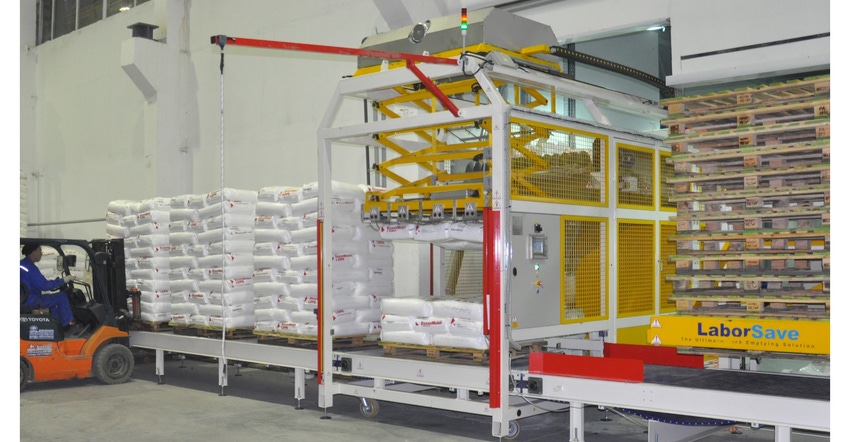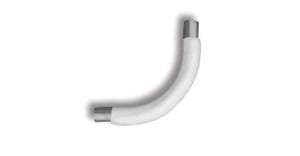Today’s fully automated bag-emptying systems offer a viable alternative to manual bag dumps, semi-automatic slitting machines, and truck and railcar supply
September 29, 2022

Scott Dahlgren, president, Carolina Material Technologies
In North America, chemicals, plastics, food stuffs, and many other bulk material solids are delivered in four distinct forms: railcar, trucks, FIBCs (bulk bags, totes, boxes), and 50-lb sacks. Small producers generally start with 50-lb sacks. As business grows, upgrades are made to accept FIBCs, then truckloads, and finally railcars being the preferred choice of product supply. These changes are made as the price/lb generally decreases with the larger volume purchases and labor costs decrease as well.
Today’s fully automated bag-emptying systems offer a viable alternative not only to manual bag dumps and semi-automatic slitting machines, but also to truck and railcar supply. But why would anyone want to “go back to sacks” when trucks can deliver product at a lower cost?
First, the fully automated system offers a true backup solution to today’s supply chain issues. Having a system that can accept pallets of sacks and maintain production levels is vital to many producers.
Second, fully automated, robot-centered, sack-emptying systems allow for greater competition within the supply chain, offering a real raw material savings in price/lb (worldwide market supply), while requiring only one part-time operator.
Bag Emptying Options: Manual to Fully Automated
When dealing with sacks most producers utilize manual, filtered, bag dump stations. A small percentage have moved to a semi-automatic option. In the last decade, robotic, fully automatic systems have become available. Solution choices include:
1. Manual cut and dump bag dump stations. This is the most prevalent design currently used in the North American marketplace.
2.Semi-automatic. Manually loading an automated cutting system
3.Fully automated systems. Full pallet loading of the machine with automated lifting, cutting, and emptying
Manual Bag Dump Stations
Operators are required to manually handle these sacks. Bags are removed from a pallet--generally by manual lifting--and then placed on a filtered or unfiltered station. The bags are then manually cut with a knife, turned, lifted, and shaken--if the operator is inclined--and the empty bag is generally placed in a trash bin outside the station. Optionally an integral bag compactor can be provided.
Advantages:
Low initial investment
Good dust control, when filtered
Disadvantages
Bag yield losses (1-2% of product left in the bag
Low product purity
High contamination in the process (cigarette butts, knife shavings, hair, blood, bag pieces, other) which leads to either yield loss or returned product
Injuries (back and lacerations) and insurance claims
High labor turnover
High labor cost
Environmental/plant contamination in dealing with empty bags
Cost of Product Loss – Yield
Studies suggest the average employee only empties 98-99% of the sack content. This is driven by the time available to empty each sack and is also operator dependent.
With a 50-lb sack valued at $50 and a 1% loss
$.50 of product is thrown away with each bag.
Running just 400 bags/8 hours, $200 of product is lost at each shift.
At two shifts/day x 320 days working per year, $128,000 is lost per year.
Repurposing or eliminating an operator (or two or three) offers additional savings, while, by implementing a robot, sick days, tiredness and job dissatisfaction become a past problem.
Semi-automatic - Manually Loaded Cutting Systems
This system is generally implemented to deal with higher usage capacity. These units require operators to manually remove the bags from the pallet, placing each bag on a belt conveyor or similar, which takes the bag into the automated cutting and discharge system. The cutting system protects the worker from the cutting blade(s), minimizing contamination, and helps control dust during discharging. Various cutting and bag-emptying systems are utilized to empty each bag, but generally a rotating drum is utilized to screen the product from the bag. Cutting systems range from one to three blades, with the three-blade unit offering higher product yields. Yield ranges from 97-99.5%, depending upon the system.
Advantages
Higher capacity: up to ~360 bags/hour for one operator; one bag/10 seconds
With more operators, higher capacities can be reached
Automatic bag cutting and bag emptying
Dust control
Operator protection: no injuries from knives
Empty bags are compacted at discharge
Disadvantages
Operator(s) required to lift/manipulate each bag
Contamination and screen blinding
Bag yield losses – 0.5 - 3% of product left in the bag, depending upon system
Back injuries and insurance claims
High employee turnover
High labor cost
Cost of Product Loss – Yield
At 99.5% emptying efficiency
With a 50-lb sack valued at $50 and a 0.5% loss
$.25 of product will be thrown away with each bag
Running (360 bags/hr) 2,880 bags/8 hours, $720 of product is lost at each shift.
At two shifts/day x 320 days working per year, $460,800 is lost per year.
Fully Automatic Unloading System
Two automated technologies exist. The first dumps an entire pallet of bags into a rotating, cutting drum. Resembling a giant blender, this machine destroys the sack to release the contents, inevitably mixing pieces of sack into the raw material. Whatever problem is solved by speed is replaced by a new problem: having to filter out the desired material from the shredded waste.
Using the “tumbling" method, the mixture is spun with force against a cylinder with holes like a sieve. Some of the holes become plugged by sack fragments or material, while tiny sack bits escape through other holes contaminating the sifted product. Waste of the purchased product averages about 2%, making this fully automatic process a costly one. Increasing the processing speed increases that loss - as much as a 3-4%. Additionally, maintenance is moderately high, due to the aforementioned.
The second technology, which will be the focus, is robotic centered and was introduced to the European marketplace in 2004. The system was born out of a root cause analysis exercise at a plastics factory looking to minimize or eliminate operator injuries. Safety, efficiency, reduction in contamination and labor costs were the focus in developing the fully automatic robotic system. This system offers product losses of less than 0.01%.
Robotic Systems
The system design is centered around the integral robot, completely removing the need for operators to lift, place, cut, or empty the sacks.
Industrial robots have changed modern manufacturing facilities by stacking filled bags, for example, thus eliminating the back-breaking, repetitive jobs that often lead to injuries, insurance claims, and high employee turnover. In North America, since the great resignation, these types of jobs have become extremely hard to fill and almost impossible to retain teammates in this role.
The automated system incorporates a robot to pick, cut, discharge, and compress empty bags in a repetitive cycle. As this is a robot, the uptime is nearly 100%. These systems can unload any quantity of bags, up to ~1,300 bags/hour (32.5 tn/hr) with a 99.99% emptying efficiency.
Precision SS hooks “pick” the top row of bags, regardless of the number of bags, placement on the pallet, or orientation. The design allows for 8-12 hooks to capture a single bag. The hooks are generally engineered to plug the hole made, thereby preventing product leakage from the sack when lifting and moving each sack. The sacks are run across a series of motorized cutting blades above the discharge hopper. These blades, run when the bags are run across the tips, at a precise height, to ensure the cleanest cut possible. Each bag--depending upon orientation--receives 3-6 cuts.
Product purity is maintained by the ultra-sharp, hardened, motorized knives, as well as implementing a screen in the hopper discharge.
99.99% Bag Emptying Efficiency
After the bags are cut, they are placed onto a series of rods, which line up with the slits in each bag and are then aggressively vibrated. These bags are left on the shaking system for 15-30 seconds, which results in a 99.99% emptying efficiency.
Integral Bag Compaction
The empty bags are discharged into a square collection hopper where they are compressed every ‘x’ cycles, which allows for the compression of 1,500-2,000 empty bags. These compressed bags fall onto a client-inserted pallet and are removed via fork truck when full.
Alternatively--and with the higher capacity units--an automated baler can be provided. This baler pulls the discharged bags through an inlet hopper, into the baler, for compaction and baling. The baled bags are discharged horizontally for palletizing.
Product is discharged through an integral hopper to pneumatic or mechanical systems to downstream processes, including silos. Alternatively product can be loaded into FIBCs.
With all units one part-time operator is required to operate the system. The job requires loading the full pallets, removing the empty pallet stack and removing the compacted bags.
Advantages
High capacity: up to 1,300 bags/hr with one operator (32.5 tn/hr)
Bag yield of 99.99% guaranteed
Automatic lifting, cutting, shaking, and bag emptying
High product purity
Operator protection
Lower insurance rates
Minimizes contamination
Empty bags are compacted at discharge
Low labor requirements and cost
Low turnover
Dust control: when enclosed and connected to a dust collector
Can handle most bag types, including plastic, woven, laminated paper, jute
Disadvantages
Cannot handle 1-3 layered paper bags if they are unlaminated or unlined
Requires a sizeable dust collector for dusty products
Cost of Product Loss – Yield
With a guaranteed >99.99% emptying efficiency
With a 50-lb sack valued at $50 and a .01% loss
$.005 of product will be thrown away with each bag
Running 360 bags/hr (2,880 bags/8 hours); $14.40 of product is lost at each shift.
At two shifts, operating at 320 days/year: $9,216 is lost per year
Summary
The current, robotic-centered, fully automated sack-unloading systems offer a viable solution not only to other bag slitting systems but to truck and railcar material sourcing as well. Due to the efficiencies and reliability of these systems, producers can now access the worldwide supply of many bulk materials, which translates into increased profitability, while maintaining or increasing current production levels. Worldwide market access and automation are required to remain competitive in today’s marketplace. With a solution to reliably unload 50-lb sacks, many products can now be sourced from overseas, at a lower cost than local truck and rail supply. At the same time, utilization of this equipment allows for increased leverage with local suppliers, all driving increased profitability.
Scott Dahlgren is president, Carolina Material Technologies, the North American Distributor for Ayal Robotics’ LaborSave, the inventors of robot-centered sack-unloading systems. Dahlgren has more than 35 years of bulk material handling experience. For more information, call 800-299-4994 or visit www.cmtnc.com.
You May Also Like


